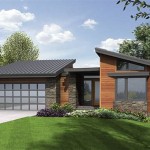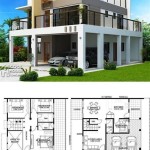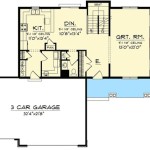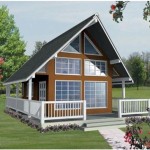House plans for small lots are specialized architectural designs specifically created to maximize space utilization and functionality in limited land areas. They typically cater to individuals, families, or couples seeking to optimize space while maintaining their desired living standards.
With the increasing scarcity and rising costs of land, especially in urban and densely populated regions, house plans for small lots have emerged as a popular and practical solution. These plans enable individuals to build homes that meet their needs within constrained lot sizes. They offer a cost-effective and efficient way to achieve homeownership while balancing factors such as space, budget, and lifestyle.
When designing house plans for small lots, certain key considerations should be taken into account to ensure optimal space utilization and functionality:
- Maximize vertical space
- Incorporate multi-purpose areas
- Utilize natural light
- Design efficient storage solutions
- Create flexible floor plans
- Consider outdoor living spaces
- Prioritize energy efficiency
- Adhere to local building codes
- Seek professional architectural assistance
By addressing these important points, house plans for small lots can effectively address the challenges of limited space while creating comfortable and livable homes.
Maximize vertical space
In house plans for small lots, maximizing vertical space is crucial to creating a sense of spaciousness and accommodating all necessary functions within a limited footprint. This can be achieved through various design strategies:
Loft and Mezzanine Levels: Incorporating loft or mezzanine levels adds additional living space without expanding the home’s footprint. These elevated areas can be used for bedrooms, home offices, or storage.
High Ceilings: Opting for higher ceilings, especially in common areas like the living room and kitchen, creates an illusion of grandeur and makes the space feel more open and airy.
Vertical Storage: Utilizing vertical storage solutions, such as tall bookshelves, wall-mounted cabinets, and pull-out drawers, maximizes vertical space and keeps clutter off the floor.
Built-in Features: Designing built-in features, such as window seats with storage underneath or Murphy beds that fold into the wall, optimizes space and provides additional functionality.
Incorporate multi-purpose areas
In house plans for small lots, incorporating multi-purpose areas is a clever design strategy to maximize functionality and adaptability. These spaces serve multiple purposes, eliminating the need for dedicated rooms and enhancing the overall efficiency of the home.
Living Room as a Multi-Purpose Space: The living room can be transformed into a multi-purpose area by incorporating features such as a pull-out sofa bed for guests, built-in bookshelves for storage and display, and a designated workspace for a home office.
Kitchen with a Dining Nook: By extending the kitchen counter to create a bar-style seating area, the kitchen can double as a dining space, eliminating the need for a separate dining room.
Flexible Guest Room: A guest room can be designed to serve multiple functions by incorporating a fold-away bed that can be stored when not in use. This allows the room to be used as a home office or a playroom during the day.
Loft as a Versatile Space: A loft area can be designed to adapt to various needs. It can serve as an additional bedroom, a home gym, or a creative studio, providing flexibility and maximizing the home’s potential.
Utilize natural light
In house plans for small lots, maximizing natural light is essential for creating a bright, inviting, and energy-efficient living space. Incorporating natural light sources not only enhances the aesthetic appeal of the home but also reduces reliance on artificial lighting, leading to lower energy consumption.
- Windows and Skylights: Strategically placed windows and skylights allow ample natural light to flood the interior, creating a sense of spaciousness and reducing the need for artificial lighting during the day. Clerestory windows, positioned high on the walls, are particularly effective in bringing light into rooms with limited wall space.
- Light-Colored Walls and Finishes: Using light-colored paints and finishes on walls, ceilings, and flooring reflects natural light more effectively, making the space feel brighter and more open. Darker colors, on the other hand, absorb light, making the room appear smaller and dimmer.
- Open Floor Plans: Open floor plans, with fewer walls and partitions, allow natural light to penetrate deeper into the home. By connecting different areas of the house, such as the living room, dining room, and kitchen, natural light can flow more freely throughout the space.
- Mirrors and Reflective Surfaces: Incorporating mirrors and reflective surfaces, such as metallic accents or glossy tiles, bounces natural light around the room, amplifying its effect and creating the illusion of a larger space.
By implementing these strategies, house plans for small lots can harness the transformative power of natural light to create a more inviting, energy-efficient, and visually appealing living environment.
Design efficient storage solutions
In house plans for small lots, designing efficient storage solutions is paramount to maintaining a clutter-free and organized living space. By maximizing vertical space, incorporating built-in features, and utilizing multi-purpose furniture, homeowners can optimize storage capacity without sacrificing style or functionality.
- Vertical Storage: Utilizing vertical space through tall bookshelves, wall-mounted cabinets, and stackable storage bins allows for ample storage without taking up valuable floor space. Floating shelves, mounted high on walls, provide additional display and storage options without creating a sense of clutter.
- Built-In Features: Incorporating built-in features, such as window seats with hidden storage compartments or drawers under staircases, maximizes space utilization and provides discreet storage solutions. Custom-built cabinets and closets can be tailored to fit specific storage needs, ensuring optimal use of every nook and cranny.
- Multi-Purpose Furniture: Choosing furniture that serves multiple purposes is a clever way to save space in small homes. Ottomans with built-in storage can double as seating and provide additional storage for blankets, pillows, or toys. Nesting tables can be stacked together to create a larger surface area when needed and tucked away to save space when not in use.
- Hidden Storage: Concealing storage behind decorative panels, under beds, or in the walls creates a seamless and clutter-free look. Pull-out drawers and sliding shelves make it easy to access items without creating visual clutter.
By implementing these efficient storage solutions, house plans for small lots can maximize functionality and create a comfortable, organized, and visually appealing living space.
Create flexible floor plans
In house plans for small lots, creating flexible floor plans is essential to accommodate changing needs and maximize space utilization. By incorporating elements such as movable walls, multi-purpose spaces, and open layouts, homeowners can adapt their living spaces to suit their evolving lifestyles.
- Movable Walls and Partitions: Using movable walls or partitions allows for the reconfiguration of spaces to suit different needs. These movable elements can create separate rooms or open up the floor plan to create a more spacious feel.
- Multi-Purpose Spaces: Designing multi-purpose spaces that can serve multiple functions is a clever way to maximize space in small homes. For example, a living room can double as a guest room by incorporating a pull-out sofa bed, or a dining area can be transformed into a home office with a fold-away desk.
- Open Layouts: Open floor plans, with fewer walls and partitions, create a sense of spaciousness and allow for greater flexibility in furniture placement. By connecting different areas of the house, such as the living room, dining room, and kitchen, open layouts promote a more fluid and adaptable living space.
- Built-In Flexibility: Incorporating built-in features that offer flexibility is a smart design strategy. For example, installing sliding doors or pocket doors instead of traditional swinging doors can save space and allow for different configurations of the room.
By creating flexible floor plans, house plans for small lots empower homeowners to adapt their living spaces to their evolving needs and create a more comfortable and functional home.
Consider outdoor living spaces
Incorporating outdoor living spaces into house plans for small lots is a smart design strategy that extends the living area beyond the confines of the home and enhances the overall quality of life. By creating seamless transitions between indoor and outdoor spaces, homeowners can enjoy the benefits of outdoor living without the need for a large backyard.
- Patios and Decks: Adding a patio or deck to a small lot home provides an additional outdoor living space that can be used for dining, entertaining, or simply relaxing. By utilizing vertical space with planters and trellises, homeowners can create a lush and inviting outdoor oasis even in limited areas.
- Balconies and Rooftops: Balconies and rooftop terraces offer elevated outdoor spaces that maximize views and provide a sense of privacy. These areas can be furnished with comfortable seating and outdoor lighting to create intimate and inviting retreats.
- Courtyards and Atriums: Enclosed courtyards and atriums bring the outdoors into the heart of the home, providing natural light and ventilation while creating a private and serene outdoor sanctuary.
- Vertical Gardens and Green Walls: Incorporating vertical gardens or green walls into small lot homes is a creative way to add greenery and create a sense of connection with nature. These living walls can be installed on balconies, patios, or exterior walls, transforming vertical spaces into vibrant and sustainable features.
By carefully considering outdoor living spaces in house plans for small lots, homeowners can create functional and inviting extensions of their homes that enhance their living experience and provide a valuable connection to the outdoors.
Prioritize energy efficiency
In house plans for small lots, prioritizing energy efficiency is crucial to reduce energy consumption, lower utility bills, and contribute to a more sustainable living environment. By incorporating energy-efficient features and design strategies, homeowners can create comfortable and eco-friendly homes that minimize their environmental impact.
Insulation and Air Sealing: Proper insulation and air sealing are essential for maintaining a comfortable indoor temperature while reducing energy loss. Installing high-quality insulation in walls, ceilings, and floors helps regulate heat flow, preventing heat from escaping during winter and entering during summer. Additionally, sealing air leaks around windows, doors, and other openings minimizes drafts and improves overall energy efficiency.
Energy-Efficient Appliances and Fixtures: Choosing energy-efficient appliances and fixtures, such as LED lighting, ENERGY STAR-rated refrigerators, and low-flow faucets, can significantly reduce energy consumption. These appliances and fixtures use less energy to operate, leading to lower utility bills and a reduced carbon footprint.
Passive Solar Design: Passive solar design principles can be incorporated into house plans for small lots to harness the sun’s energy for heating and lighting. By positioning windows and skylights to maximize natural light and heat gain, homeowners can reduce their reliance on artificial lighting and heating systems, resulting in energy savings and a more comfortable living environment.
Prioritizing energy efficiency in house plans for small lots not only reduces energy costs and environmental impact but also enhances the overall comfort and livability of the home. By implementing these energy-saving strategies, homeowners can create sustainable and cost-effective living spaces that promote well-being and minimize their ecological footprint.
Adhere to local building codes
Adhering to local building codes is paramount when designing and constructing house plans for small lots. These codes establish minimum standards for the safety, health, and structural integrity of buildings, ensuring that they meet specific requirements set forth by local authorities.
Building codes address various aspects of construction, including:
- Zoning regulations: These regulations determine the permitted uses of land and the size, height, and setbacks of buildings within specific zones.
- Structural requirements: Building codes specify the minimum structural requirements for buildings to withstand various loads, such as dead loads (the weight of the building itself), live loads (occupants and their belongings), and environmental loads (wind, snow, earthquakes).
- Fire safety regulations: These regulations aim to prevent and mitigate the spread of fire, including requirements for fire-rated materials, smoke detectors, and emergency exits.
- Plumbing and electrical codes: Building codes establish standards for the installation and maintenance of plumbing and electrical systems to ensure safety and functionality.
- Energy efficiency requirements: Many building codes now incorporate energy efficiency standards to promote sustainable building practices and reduce energy consumption.
By adhering to local building codes, homeowners and builders can ensure that their house plans for small lots meet the necessary safety and quality standards, ensuring the well-being and comfort of occupants while safeguarding the structural integrity of the building.
Seek professional architectural assistance
When dealing with house plans for small lots, seeking professional architectural assistance is highly recommended. Architects possess the knowledge, skills, and experience to design and create plans that optimize space utilization, functionality, and aesthetic appeal while adhering to local building codes and regulations.
Expertise in Space Planning: Architects are trained to maximize space utilization, especially in small lot designs. They can create innovative floor plans that seamlessly integrate different functional areas without compromising comfort and flow.
Technical Proficiency: Architects are well-versed in building codes, structural requirements, and construction techniques. Their technical expertise ensures that house plans are structurally sound, safe, and compliant with local regulations.
Design Creativity: Architects bring creativity and innovation to the design process. They can develop unique and visually appealing designs that cater to the specific needs and preferences of homeowners while considering the constraints of small lot sizes.
Engaging a professional architect for house plans for small lots offers numerous benefits. Their expertise ensures optimal space planning, technical accuracy, and creative design solutions, leading to homes that are both functional and visually pleasing. While professional architectural assistance may involve additional costs, it is a worthwhile investment that can save time, money, and potential headaches in the long run.










Related Posts








